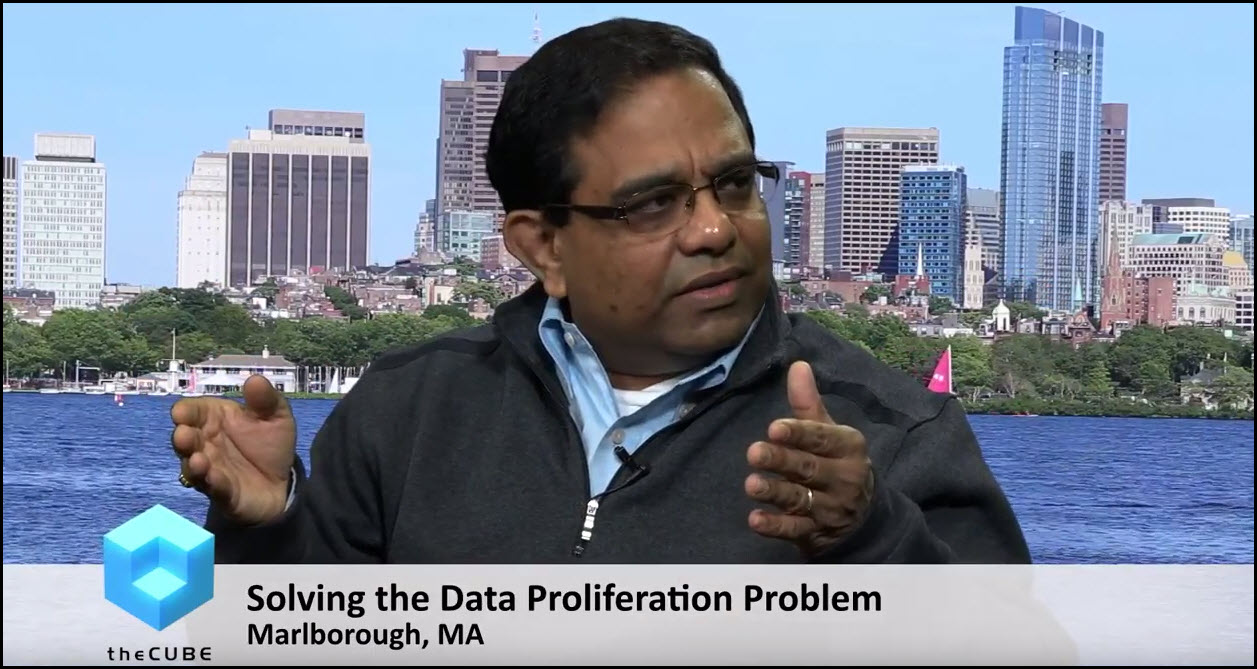 NEWS
NEWS
 NEWS
NEWS
 NEWS
NEWS
Big data and the Internet of Things have created an explosion of data, and with it a new set of problems for information technology organizations. Not only do they need to store and manage all that data, but they also must control the multiple copies that are needed to satisfy the applications that use it.
Application developers, data scientists and business analysts each may demand access to the same data sets, and for most organizations that means creating new copies. In fact, Gartner estimates that companies typically keep between 30 and 40 copies of their business data for different purposes, creating cost and complexity and giving rise to a new market called “copy management.”
Actifio Inc. has stepped into that breach with a technology it calls “storage copy data virtualization.” The idea is to do with data what has already been done with computers, storage devices and networks: make it distributed, location-independent and instantly accessible through software.
Actifio’s Virtual Data Pipeline technology essentially creates a single “golden copy” of an organization’s entire data store and exposes it via application program interfaces to the people and applications that need it. What’s more, customers can restore data to any point in time in minutes, a capability useful for companies struggling with collapsing backup and restore windows.
The concept is like Apple’s Time Machine or Windows’ File History feature, both of which store incremental file snapshots. That’s simple to do on the desktop, but “very, very hard to do at enterprise scale,” Actifio Chief Executive Ash Ashutosh said in a CUBE Conversation interview (below). “It’s about being super-efficient at capturing data, storing it, moving it and managing it.”
Actifio created a distributed object filesystem with a single namespace that tracks data context and handles mobility and workflow. Its change management and de-duplication architecture stores data about changes in storage blocks rather than entire copies of files. As a result, “You can tap into your SAP data from 14 days ago with a single API, or call up last year’s data and run Hadoop on it without having to create another pool of storage,” Ashutosh said.
The entire data store is virtualized so that users also needn’t worry about where data is located. In concept, virtual data isn’t that different from virtual machines or networks. Images are stored in software for fast deployment without regard for where the data is physically located. “It’s the most efficient way of moving data around. You can spin up any app you want right where the data is,” Ashutosh said. Actifio is designed to understand the context of data, so that it can restore exact images from any point in time.
Actifio’s approach is aligned with where IT is going, Ashutosh said. “There’s a fundamental change in the way people think about infrastructure. Sheet metal and blinking lights are being replaced by APIs,” he said. “It’s thinking about application logic instead of storage LUNs (logical unit numbers).”
Actifio may not be a household name, but in the storage market it’s an increasingly powerful force. The company has raised $225 million in venture financing and was recently valued at $1.2 billion. More than 1,100 enterprises use Actifio, including 60 of the largest service providers that sell data, Ashutosh said. Its core market is “global 2000” organizations that spend massive amounts of money capturing data and shuttling around the world.
Copy management is a relatively recent problem that has been created by the explosion of interest in DevOps and big data, both of which demand copies of production and historical data. Creating those copies not only consumes storage resources and bandwidth but presents security and operational problems in areas such as backup and recovery.
Founded in 2009, Actifio spent its early years evangelizing the cost-saving benefits of eliminating duplication. “It was about commoditizing storage. You didn’t need all the fancy snapshot and replication. You just needed a reliable storage box that could run your data management software,” Ashutosh said. The cost savings alone can be impressive. One U.K. customer eliminated nearly £300 million in storage infrastructure by consolidating data, the CEO said.
More recently, the value story has shifted to speed and simplicity as customers have learned that not having to wait days or weeks for data copies to be allocated enables them to build applications faster. One organization discovered that it could restore its entire data center – a process that used to take eight weeks – in 20 minutes, according to Ashutosh.
Now customers are tapping into the benefits of quick access to historical data for rapid application development and analytics. “In two years we went from 0 percent to 43 percent of our business being based on DevOps and agility,” Ashutosh said. “Speed is more important than saving money.”
Having grown from 50 people to more than 400 in five years while achieving “unicorn” status, Actifio has naturally raised speculation about its plans for an initial public offering. Ashutosh said there’s no rush. “We shifted about a year ago to focusing on being a profitable company,” he said. “The day customers tell us we have to become a public company for transparency reasons, we’ll consider it.”
THANK YOU